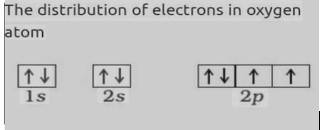Structure of Atoms
Get insights from 148 questions on Structure of Atoms, answered by students, alumni, and experts. You may also ask and answer any question you like about Structure of Atoms
Follow Ask QuestionQuestions
Discussions
Active Users
Followers
New answer posted
4 months agoContributor-Level 10
This is a Short Answer Type Questions as classified in NCERT Exemplar
Ans: The electronic configuration of nickel is 1s2 2s2 2p6 3s2 3p6 3d8 4s2 , thus it loses electrons from its 4s orbital as its energy is higher compared to the other orbital.
New answer posted
4 months agoContributor-Level 10
This is a Short Answer Type Questions as classified in NCERT Exemplar
Ans: The electronic configuration of oxygen atom is 1s2 2s2 2p4 and its orbital diagram is given by

New answer posted
4 months agoContributor-Level 10
This is a Short Answer Type Questions as classified in NCERT Exemplar
Ans: The effective nuclear charge (Zeff) is defined as the net positive charge experienced by the outermost electrons in the atom. With the increase of Azimuthal quantum number (l) the Zeff experienced by the electron decreases. Hence the arrangement of subshells in the increasing order of Zeff is : d
New answer posted
4 months agoContributor-Level 10
This is a Long Answer Type Questions as classified in NCERT Exemplar
Ans: The drawbacks of Bohr's model were
(i) It was unable to explain the spectra for multi-electron systems
(ii) It could not explain the molecule formation through chemical bonds. The two important developments that contributed significantly towards the change of concept of movement of an electron in an orbit was replaced by, the concept of probability of finding an electron in an orbital were
(i) Dual nature of matter
(ii) Uncertainty Principle. Quantum mechanical model of the atom is the name of the new model.
New answer posted
4 months agoContributor-Level 10
This is a Long Answer Type Questions as classified in NCERT Exemplar
Ans: We have
v= 109677 [1/ni 2 - 1/nf 2 ]
Given, ni = 3 and nf =2
D E= hcv = 109677 [1/ni 2 - 1/nf 2 ]
DE = - 3.052 * 10-19J
n =DE /h= 4.606 * 1016Hz
New answer posted
4 months agoContributor-Level 10
This is a Long Answer Type Questions as classified in NCERT Exemplar
Ans: The points of the Bohr's model that can be consider are as follows: -
(i) Electrons revolve around the nucleus in a fixed orbit with fixed energy
(ii) The energy is absorbed or released when the electron moves from one energy level to another. The energy for the nth stationary state is given by
En = -2 p 2me4 /n2h2
Where
m = mass of the electron
e = charge of the electron
h= Planck's constant If an electron jumps from ni to nf then we have
D E= Ef - Ei = 2p2me4 /h2 [ (1/ni 2 ) - (1/nf2 )]
v = DE /hc = 109677 [ (1/ni 2 ) - (1/nf2 )]
New answer posted
4 months agoContributor-Level 10
This is a Long Answer Type Questions as classified in NCERT Exemplar
ANS- For the emission of electrons from metal the frequency of the striking light should be higher than that of its threshold frequency. We have
h ν = hν 0 + K.E
ν 0 = ν - K.E/h ……. (1)
Given
ν = 1015 s -1, K.E = 1.988 X 10-19J
Thus (1) gives
ν 0 = 7 x 1014 s -1
Given
λ = 600 nm
ν = c/ λ = 5 x 1014 s -1
As ν 0 > ν, thus the electrons do not emit.
New answer posted
4 months agoContributor-Level 10
This is a Long Answer Type Questions as classified in NCERT Exemplar
ANS-When the beam of light gets exposed to the metal surface then the electrons get emitted from the metal. This effect is said to be photoelectric effect and the emitted electrons are said to be photoelectrons. The result of photoelectric experiment are as follows: -
(i) There is no time gap between the striking of a light beam and the ejection of electrons from the metal surface i.e., electrons emit as soon as a beam of light strikes the metal surface.
(ii) The number of electrons ejected is directly proportional to the intensity of light.
(iii) For every metal there
Taking an Exam? Selecting a College?
Get authentic answers from experts, students and alumni that you won't find anywhere else
Sign Up on ShikshaOn Shiksha, get access to
- 65k Colleges
- 1.2k Exams
- 687k Reviews
- 1800k Answers
